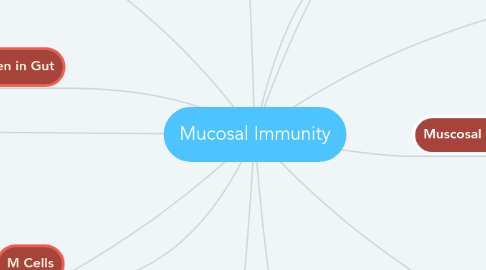
1. GD vs T cells
1.1. AB and GD cells present in intestine
1.2. AB T cells tightly regulated in thymus whereas GD develop extrathymically in liver and gut
1.3. GD T cells express RAG1 and are homodimeric for CD8- AACD8
1.4. FCER1 acts as component of the GD T cell complex
1.5. GDT cells are oligoclonal- not diverse, far fewer TCR permutations
1.6. TCRGD polyclonal in newborns
1.6.1. GD T cells may be important in earl mucosal defense before AB T cells and IgA response is developed
2. Function of GD Intraepithelial Lymphocytes
2.1. Surveillance of intestinal epithelial layer against microbial invastion
2.1.1. Cytotoxic against microbial pathogens by lysing infected cells
2.1.2. Provide B cell help
2.1.3. Produce cytokines and chemokines
2.2. Support Epithelial cell growth and maintenance of barrier integrity
2.2.1. Production of growth factors- keratinocyte growth factor
2.2.2. Removal of damaged or transformed epithelial cells
2.3. Immunoregulatory functions
2.3.1. Abrogating/ promoting oral tolerance
2.3.2. Producing immunoregulatory cytokines
3. Peyer's Patches
3.1. Organised lymphoid Tissue aggregates composed of:
3.1.1. Specialised follicle associated epithelium (FAE)
3.1.2. Overlying a subepithelial Dome (SED)
3.1.3. Overlying B cell follicles containing germinal centres (GC)
3.1.4. Interfollicular regions (IFR) contain T cells, high endothelial venules (HEV) and efferent lymphatics
3.1.5. All lymphoid migration occurs from blood across HEV- no afferent lymphatics
4. M Cells
4.1. Primary site of antigen handling in gut
4.2. Specialised epithelial cells
4.2.1. Poorly developed brush border
4.2.2. No microvilli
4.2.3. Thin glycocalyx
4.2.4. No hydrolytic enzymes
4.2.5. Express MHCII on basolateral surface
4.2.6. Rich in pinocytotic vesicles
5. Fate of antigen in Gut
5.1. Preprocessed in gastric lumen
5.1.1. Gastric acid
5.1.2. Gastric enzymes
5.1.3. Pancreatic proteases
5.2. Antigen absorbed but doesn't evoke reponse
6. Antigen Sampling
6.1. Dendritic route
6.1.1. Dendritic cell samples luminal antigen from intestinal lumen and presents this to lymphatic cells
6.2. Epithelial cell route
6.2.1. Antigen translocates through epithelial cells of intestine
6.2.2. Can be taken by macrophages to be presented
6.2.3. Can directly enter into circulation by passing through lamina propria into capillaries
6.2.4. Sampled by dendritic cell where it's presented to T cells in interfollicular regions in follicles to stimulate IgA production
7. Lymphocyte Homing to Tissue
7.1. Tissue selective trafficking
7.2. Initial exposure to antigen in mucosal inductive sites- peyer's patches
7.3. Efferent lymphatics
7.4. Mesenteric lymph nodes
7.5. Blood
7.6. Mucosal homing- expression of a4b7 on lymphocytes
7.7. Expression of CAMS on lamina propria
8. Challenges of the GI imune system
8.1. GI surface are is 400 metres squared
8.2. Single layer of epithelium covers this to allow for efficient nutrient absorption
8.3. Must discriminate between non-pathogenic antigens- dietary proteins and commensals- and pathogenic microbes
9. Muscosal Lymphoid Tissue
9.1. Mucosal associated lymphoid tissue across all mucosal surfaces (MALT)
9.2. Gastrointestinal associated lymphoid tissue in GI tract (GALT)
9.2.1. Mesenteric lymph nodes
9.2.2. Peyer's patches
9.2.3. Lamina propria
9.2.4. Murine cryptopatches
9.3. 70% of lymphocytes found in gut
10. Non- specific Immune Response
10.1. Mechanical responses
10.1.1. Epithelial integrity
10.1.2. Peristalsis
10.1.3. Diarrhoea
10.2. Humoral
10.2.1. Gastric acid
10.2.2. Lysozyme
10.2.3. Peroxidase
10.2.4. Mucin
10.2.5. Antimicrobial peptides
10.2.6. Defensins
10.2.7. Trefoil proteins
11. Antibody Response in the Intestine
11.1. IgM, IgG and IgE are all present in gut lumen
11.2. IgA is a major secreted antibody of gut lumen
11.2.1. Around 3g of IgA/day in normal adults
11.2.2. Prevents attachment of bacteria, toxins, viruses and absorption of foreign substances
11.3. Some bacteria produce proteases that attack hinge region of IgA and prevent this
12. Vascular Adhesion Molecules
12.1. MAdCAM-1
12.1.1. Mucosal addressin cell adhesion molecule- selectively expressed on postcapilarry venules in lamina propria
12.1.2. Also expressed on GALT
12.2. Intestinal homing receptor a4b7
12.2.1. Heterodimeric adhesion molecules, highly expressed on intestinal memory and effector cells, ligand for MAdCAM-1
13. Importance of Lymphocyte Homing
13.1. Vaccine Development
13.1.1. How do you direct lymphocytes in gut systemically
13.1.2. How do you direct immunised lymphocytes in gut
13.2. Therapeutic implications
13.2.1. Block interactions of MAdCAM1 and a4b7 to block inflammatory lymphocytes from entering gut

